One vehicle, 40,000 km: How to do Australia’s ‘Big Lap’
By Kate Cox
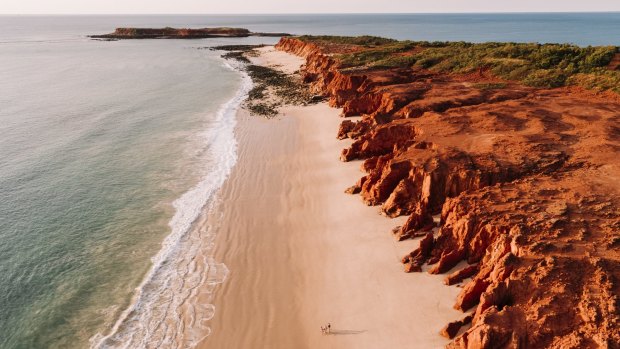
Western Beach, Kooljaman at Cape Leveque. Western Australia was a revelation – a huge, rambling state full of perfect beaches and a thriving underwater world.Credit: Tourism Western Australia
THE most common response to the news that our family was embarking on a year-long adventure around Australia was, 'I've always wanted to do that'. As though this, and not buying bricks and mortar, was the real great Australian dream, never realised.
Life and its complications and mundanities conspired to stop us taking our Aussie lap too, even though hubby and I had talked about it since the first time we met. It was easier to stick to the daily grind. But we made it out, and spent 2019 lapping Australia in a two-by-five metre camper-trailer, with our two sons, aged 10 and 12. And boy are we glad we didn't wait.
Clocking 40,000 kilometres travelling the length and breadth of this great nation changed our family for the better and gave us experiences beyond our wildest dreams. How was it that we had travelled the world, but not this phenomenal, fascinating country of so many unforgettable sights, colours and people?
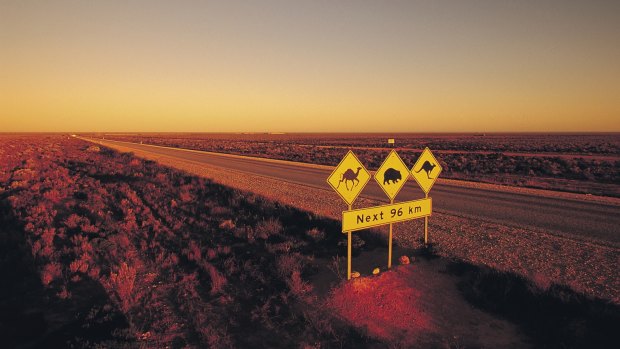
On the Nullarbor Plain, South Australia.Credit: South Australia Tourism Commission
So, my best piece of advice if you've been contemplating The Big Lap is, just do it. There's not a right time, length, budget or route but we didn't meet one traveller, whatever their circumstances, who regretted their decision to take this adventure of a lifetime. And you won't either. In the words of novelist Paulo Coehlo: If you're brave enough to say goodbye, life will reward you with a new hello. So, that's it, roll the dice. But if you want some more specific tips and tools to make the trip a reality, read on.
THE DREAM
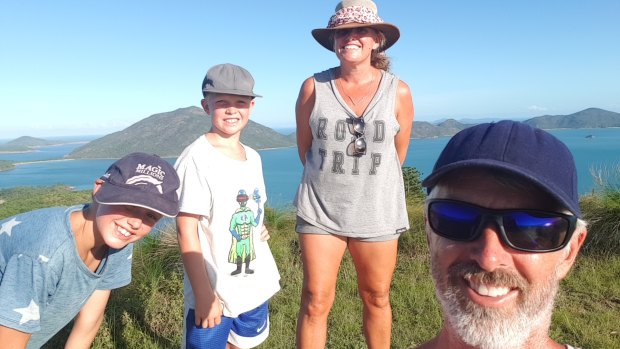
You don't need to be a grey nomad or even an experienced camper or (eek!) home-schooler. You just need to have a dream, a vague idea of your route and – most of all – a willingness to let go. I had never camped before and had spent the last two decades working long hours in an office job. But I was motivated by the opportunity to spend time with my family while exploring our backyard, which we knew not nearly enough about. We wanted to stop the clock: no screens, schedules or stuff. When my Long Service Leave collided with an opportunity for my husband to work remotely and the cusp between new schools for my sons, the trip became very real.
THE PLAN

Credit: Kate Cox
Taking a year off work and school required dozens of to-do lists – for at-home admin, kid organising, on-the-road plans and everything in between – with thousands of decisions and deadlines. Six months out, the spread-sheeting was pretty intense. Home school or distance education? Caravan, campervan or camper trailer? Rent, sell or Airbnb the house? Quit work or take leave? When to tell work and school? Do we need a new car? How do we work out a budget? We divided our many tasks into bite-sized chunks and ticked them off methodically until there was nothing left to do except cancel the post, pare down and pack up. Each family member had one small plastic box to fit whatever they wanted to take, with everything else chucked, given away or stored in a friend's half garage. We invested in Kindles instead of bulky books and took few clothes with the view that we could stop at op shops on the way. Honestly – you don't need much. For our first few months, we shed stuff at every stop – cushions, shoes, cosmetics, saucepans. Less was more.
But you really want to know how much it all cost, right? Petrol was our biggest expense, followed by food and then accommodation, with a few incidentals such as phones, insurance, new tyres and tour costs. We splurged on a few special adventures – an underground hotel in Coober Pedy, swimming with the whale sharks, a two-week catamaran trip through the Whitsundays and SCUBA diving lessons for the kids – with no regrets. But we also had days where we spent nothing – staying in free camps and cooking fish caught from the sea. A general budget is $150 a day, or $1 a kilometre.
THE PREPARATION
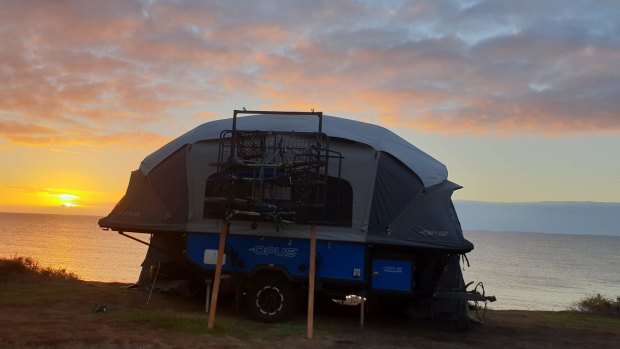
Firstly, hit at least one of those big caravan and campervan "Supershows". Lie on the beds, poke around in the fridges, pick up the pamphlets and contacts. Hubby and I are different travellers: he would have been fine in swags by the side of the road. But by meeting suppliers and tourism reps, getting input from the kids, and really checking everything out, we were able to come to a great middle ground. We purchased our Opus Air Camper on the spot at our first Supershow, with delivery in a year, and didn't regret it. It's a camper trailer that opens then blows up with a press of a button rather than stuffing around with poles – a nice compromise between a caravan that can't really go off-road and a tent, which isn't so comfortable. Buying this first meant we could work out the car we needed, and purchase the right solar panels, lights, fridge, storage solutions and more.
Next? Interrogate anyone who has done the trip. Whether you reach out to your favourite camping influencers or ask friends to hook you up with "lappers" that they know, get all the info you can. Once on the road, don't stop asking for tips: this is how we found secret free camps, owl hideaways, caves and fishing spots.
And download Wikicamps. This little app packs a punch with places to stay and things to do rated by travellers just like us. We discovered so many adventures we would not have known existed - like the Tin Can Man - that wasn't in any guide books but sounded just crazy and high-rated enough to take a detour out of Geraldton (it turned out to be a huge shed filled with thousands of biscuit tins and a great back story) and a paddock in the middle of nowhere – a high risk deviation if not for the ratings – with hundreds of fossils.
THE TRIP
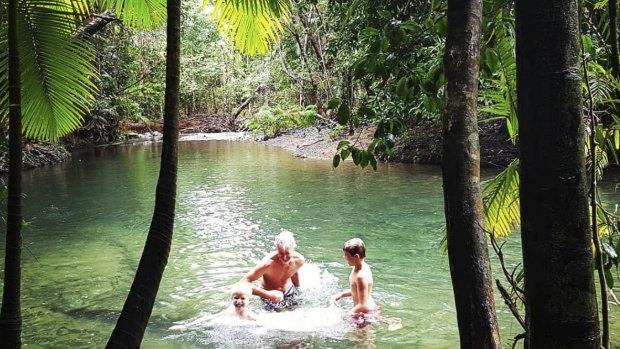
Credit: Kate Cox
It's hard to remember now, with the rose-coloured glasses of just how wonderful the year turned out – but the first six weeks were difficult, as we all worked out how to live in super-close confines with no real schedule. The trick is to relinquish control early, embrace the slow lane, communicate your needs and carve out space for some alone time. I became an early riser and started most days walking barefoot at sunrise, coming home revived rather than resentful that my day was not as autonomous as it once had been. Hubby took time out fishing. Make sure everyone is regularly fed and watered – hangry-ness can sabotage even the best road trip – but don't plan too much. With a general view to "endless summer", we had a rough route (a figure of eight up the east coast, down through the middle and across the Nullarbor, and then all the way up the west coast and back to Sydney) and some key date milestones, mainly for mates joining us in school holidays. As a planner, not locking much in freaked me out – but it was a great move. You'll meet people along the way who will change your plans and you'll value that flexibility. You'll also figure out your travelling operating rhythm pretty fast – I love research and worked out our stops and side-trips; hubby did the driving. And we all had our jobs when it came to cooking, cleaning and putting the camper up and down.
The best part about the trip was the complete and utter freedom to explore the world's most beautiful place. And the worst? Every lapping family we met moaned about home-schooling. The kids took Year 7 and 5 via different distance education organisations, in Canberra and Sydney's Inner West, but I wish we hadn't stressed so much about ticking the many boxes and concentrated more on school of life opportunities along the way. With dodgy Wi-Fi almost everywhere, it wasn't worth the frustrations and they learned so much organically.
THE PLACES
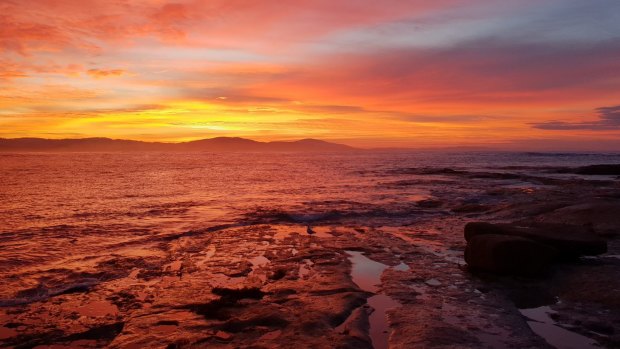
Credit: Kate Cox
On an intellectual level, we knew Australia has the oldest rainforest, best beaches and reef and most spiritual desert. But we were unprepared at how everything would exceed our expectations. We stumbled across sights that made us gasp: sand dunes and salt lakes as far as the eye could see; long natural waterslides better than any fun park; huge and overwhelming tree climbs; beaches lined with colourful shells like something out of a fantasy world. We took illuminating Indigenous tours, and had the special experience of hearing the deep stories of our history, art and culture, more than in any school books. We dug for opals, garnets, gold and dinosaur fossils. We saw dancing crabs, jumping prawns, a fever of hundreds of manta rays, biting quokkas, laughing dolphins, albino kangaroos wrestling on the beach, racing emus, feisty cassowaries, curious brolgas, intimidating crocs, cute koalas, ancient turtles, scary snakes and sharks, sea lions, seals and starfish.
Western Australia was the biggest revelation – a huge, rambling state full of perfect beaches and a thriving underwater world – so we ended up spending five months there, meaning Victoria dropped off our plans. Things change: when wild winds derailed our much-anticipated excursion to Fraser Island, so we turned left and explored the rugged Queensland outback, something we hadn't planned yet it was a move that left us with experiences and characters to remember forever. Our unanimously top-rated experience was 17 days on a 36-foot catamaran around the Whitsundays, learning to sail on the fly and exploring abandoned islands like amateur anthropologists. I'm still blown away that someone let us hire one of their beautiful boats and just sail it willy nilly. Truly a bucket list, once-in-a-lifetime adventure that we have since inspired several friends to do. All loved it.
But it's the meditative long and dusty drives – feet on the dash, face to the sun, the stunning popsicle-coloured skies slowly giving way to so many stars – that I remember most. To drive it was to feel the soul of Australia deep within.
From Henry Miller: One's destination is never a place, but a new way of seeing things.
THE HOMECOMING
Be prepared for it to be life-changing – and be proud of that. I went from cherishing my life of corporate control to craving more creativity and quality time with my children, and left my job of 21 years. The boys, although hugely excited to be back among friends, initially found the routine difficult. But they are much more confident, empathetic and independent – new, improved kids, really – and our family dynamic is so supportive that we believe we can get through anything. To beat the homecoming blues, we got Bruce the puppy to care for. A few families did have dogs on the trip, but this meant they couldn't go to national parks and had to plan around pooch food and water stoppages.
We are working hard now, secure in the knowledge that we have inspired a love of travel and this great land in our children. We also remind ourselves what we learned on the road: our personal stress impacts how we treat one another. Taking work, school and deadlines out of the equation led to a much sweeter existence. We had wobbly moments: home-schooling was hard, we were bitten by mozzies, leeches and even a quokka, our bikes were stolen in Brisbane, I perforated my ear-drum, hubby broke his toe and we all got an awkward family rash in Townsville – but we didn't argue, not even the boys, top-to-toe in their little bed. These days, we make an effort to keep laughing, cooking and exploring together. Hubby wants to sell the camper and buy an old boat but we are not really ready to part with the potential adventure it promises.
We've told each other we will do the trip again one day.
FIVE MORE MUST-SEE PLACES
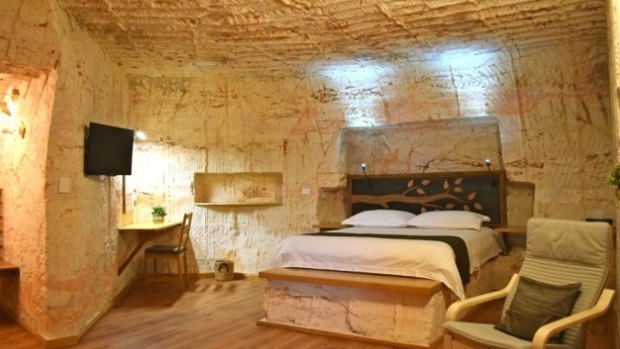
On impulse, we booked an underground B&B in Coober Pedy. Staying here and exploring this South Australian mining town is something we won't forget. See cooberpedydugoutbnb.com.au
On the beautiful Ningaloo Reef, we swam with the world's biggest fish (whale sharks) and the boys learned to SCUBA dive, something they will treasure and hopefully continue.See australiascoralcoast.com
We spent one idyllic day feeling like the Aussie Von Trapp family cycling by endless avocado, sugar cane, corn and banana plantations, on the Atherton Farm Loops Bike Trail in far North Queensland. See athertontablelands.com.au
Climbing Mount Barren in Ravensthorpe in Spring, in the Fitzgerald River National Park in Western Australia, we were blown away by huge and stunning wildflowers, the likes of which we had never seen before. See fitzgeraldcoast.com.au
There's the magic of Uluru, but Tnorala (Gosse Bluff) meteorite crater, created almost 150 million years ago by a crashing comet, and many other wonderful sights, can be found on the Northern Territory's Mereenie Loop from Uluru to Alice Springs. See nt.gov.au/leisure/parks-reserves
FIVE MORE MUST-DO EXPERIENCES
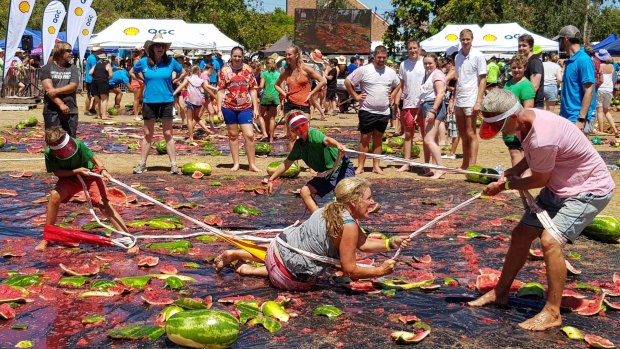
At Queensland's Chinchilla Melon Festival, we had the best time competing in wacky events like wrestling in watermelon pulp or racing with a watermelon, and then dancing on stage to Mental as Anything. I'd highly recommend you seek out festivals in the towns along the route. See melonfest.com.au
At the Remtrek stargazing tour at Dale's Campground, we saw the moon up close through guide Phil's impressive telescopes, as well as Saturn and her rings, the reds and blues of the Jewel Box, both Alpha and Beta Centurion and the Milky Way and her galaxy friends. What a privilege to learn all this, metres from our camper in the desert of Western Australia's Karijini National Park, from someone so passionate. See remtrek.com.au
On a Mossman Gorge Dreamtime walk, we learned so much from healer and tour guide, Mooks, about Indigenous food and culture. From the 400-year-old cedar used to make shields and boomerangs to nature's many poisons and cures, it was all fascinating. See mossmangorge.com.au
You haven't done the Big Lap if you haven't bounced along the Gibb River Road, a 660-kilometre former cattle track through the Kimberley in Western Australia, camping in rustic national park sites or imposing stations such as El Questro, by a natural playground full of gorges, often reached by hot, dusty walks that make the cool swims that much more rewarding. See australiasnorthwest.com
I'd expected bareness on The Nullarbor – Latin definition: "no trees" – and been told to avoid it ("Tips?" said my mate, who has done the 1675-kilometre Western Australia/South Australia track plenty of times. "Head straight for the airport.") But it was a revelation of cliffs, beaches, old ruins of telegraph stations and secret side roads promising fun 4WD adventures. We even spent one night in separate bedrooms in a deserted homestead – slightly creepy, but an adventure nonetheless. See australia.com
FIVE FAVOURITE TOWNS
BROOME, WA
There's a reason so many grey nomads fill the caravan parks in the winter months – it's a perfect base, with a laidback way of life. We rode camels and explored the huge main beach and delicious cafes, before taking off for some of the excellent eco-camps nearby, many run by passionate Indigenous families. See visitbroome.com.au
MARGARET RIVER, WA
Yep, the wine and beaches. But also the sights, including the breathtaking cave systems, all different, and the forests, rocks and walks. See margaretriver.com
COFFIN BAY, SA
On a cold Mother's Day, we pulled on thick khaki waders and toured an oyster farm, culminating in a long lunch of oysters cooked every which way, for about $1 a pop. See coffinbay.net
PEMBERTON, WA
We took lush forest walks and conquered our fear of heights with gigantic tree climbs in Pemberton (including the 63-metre high Gloucester tree).
YAMBA, NSW
If we were one of the families looking to settle somewhere along the route, this would be our sea-change spot. Beautiful beaches, walks, food and vibe. Byron before the bling.
See visitnsw.com
Sign up for the Traveller newsletter
The latest travel news, tips and inspiration delivered to your inbox. Sign up now.